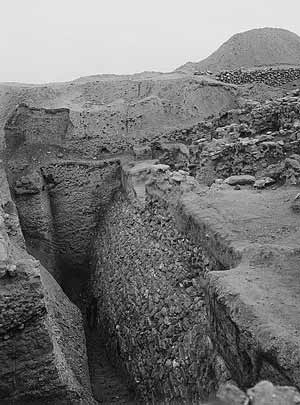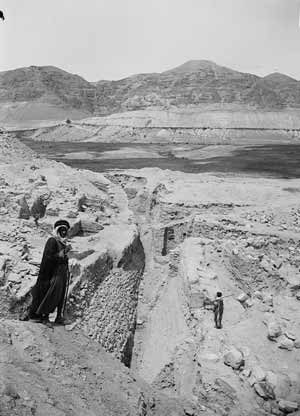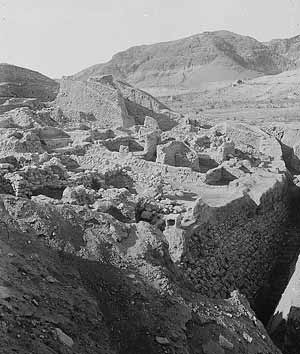 |
|
|

|
 |
|
WALLS OF JERICHO -- Excavated 1908-1909 |
The latest city walls standing at Jericho were the MBA walls built by the Hyksos people of Jericho. Their pottery and scarab seals identified them as part of the Hyksos culture that was established from the Egyptian Nile delta to Southern Israel/West Bank and extended to the north. The photos below show the stone wall, also described as a rampart or revetment. The wall was up to about 5 meters high and had a dry moat at its base. The stone wall was topped by a mudbrick wall. This city was destroyed circa 1550 B.C. at the end of the Middle Bronze Age when the native Egyptians expelled the Euro-Asiatic Hyksos from the Nile Delta and began centuries of colonization of Canaan. The Egyptian culture was imposed on Canaan as the Egyptians kept garrisons in Canaan especially with the conquests of Thutmosis III and his descendents. There was a little evidence from the tombs of a small early Late Bronze Age settlement at Jericho. This may have consisted of a few residences without the building of a new fortification wall. During the Late Bronze Age there was diminished settlement of the central hills of Israel/Palestine to the west lay without major fortification construction. The Egyptians maintained outposts at Ashkelon, Joppa, Aphek, Beth Shean, etc. during the LBA investing in occupying the fertile coastal and northern valley lands. During the Early Iron Age c. 1200-1000 B.C. the local population was resurgent and threw off the Egyptian yoke.
During 1972 a speech was given by a prominent American Biblical archaeologist indicating the book of Joshua could not be confirmed by archaeology. This speech was after the work of Kathleen Kenyon at Jericho, James B. Pritchard at Gibeon, and others contradicted Biblical stories about the conquest of Canaan by Joshua. Scholars at Copenhagen, Sheffield, and elsewhere agree to theories the first books of the Bible cannot be described as historical. They may be described as literature.
The ancient Israeli culture of burnt offerings, sacrifices, and El worship is parallel to some of the religious practices described in a clay tablet cuneiform library discovered at Ugarit/Ras Shamra, Syria in the early 20th century. It is likely Israel sprang from a regional El worshipping Canaanite culture with some influences from long term Late Bronze Age Egyptian occupation of Canaan.
Views of the Middle Bronze Age wall in the NW quarter of ancient Jericho
 |
|
|

|
 |
View from the East to the West, NW corner Jericho
MBA Walls of Jericho after the Sellin-Watzinger Expedition
University of Rome Jericho Expeditions Web Site 1997-2000, 2009-2010 Excavation Reports